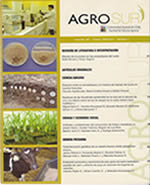Characterization of sequence of Ahas and psbA genes related to herbicide resistance in Lupinus albus L.
Main Article Content
Abstract
White lupine (Lupinus albus L.) is an important legume for human and animal consumption. However, this crop is a poor competitor with weeds, so their management is essential to increase yield. Among the herbicide most widely used for weed control in major crops, are inhibitors of acetohydroxyacid synthase (Ahas) (imidazolinone and sulfonylurea) and inhibitors of photosystem two (PII) (triazines, triazinones ureas). This study aimed to isolate and characterize Ahas and psbA genes related to resistance to herbicides inhibitor of Ahas and PII respectively. The coding region of these genes in Lupinus albus was amplified (PCR) and sequenced. These are potential sites containing the mutation involved in resistance to the described herbicides. In the gene Ahas we confirm the existence of a mutation (Gly654 → Asn) at a site previously reported to cause resistance to imidazolinones in other species. This point mutation is conserved in various legumes.

